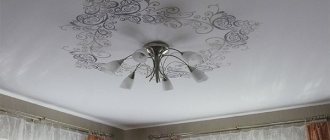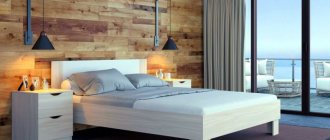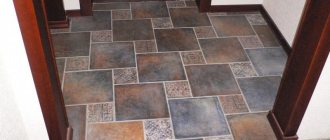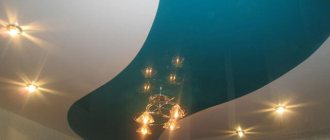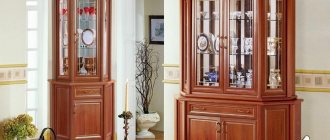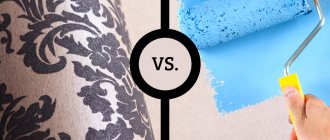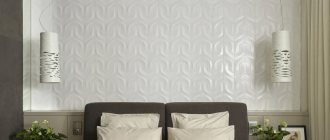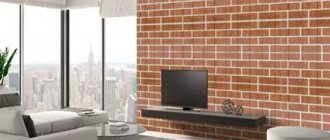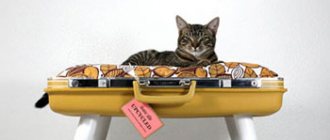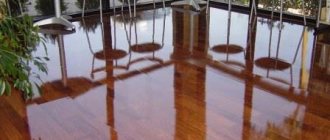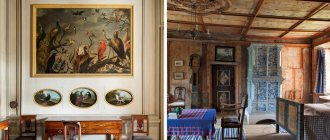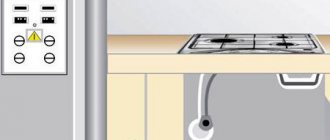What is it and what does it consist of?
MDF is a medium density fibreboard. The two most common forms of material are panels and sheets. Quality and service life do not depend on the shape.
It is made from small sawdust, just like chipboard. In the case of MDF, fine fraction sawdust is used, which allows you to create a more dense and reliable structure. According to GOST, slabs are smooth, even and uniform, so they are easy to work with - veneering, processing and milling.
MDF - medium density fiberboard
Manufacturing process
MDF is made from wood, crushed to the state of fine chips, almost to the state of fibers. Wood processing waste is used as raw material, so the production of this material can be considered environmentally friendly.
The ground wood is cleaned of sand and other foreign inclusions, washed and dried. The prepared mass is heated, a tape of the required width is formed from it, and then pressed. Under pressure, a natural binder, lignin, is released from heated wood fibers. It is he who is the binder in this material. The final shape of the products is given in a finishing press, which squeezes out the remaining air from the mass, forming a homogeneous MDF structure.
Before the press, a slab is formed from the mass
After pressing, the cooled material is submitted for grinding, where the flaws on the surface are removed from the MDF and the material is brought to the required thickness.
Not all types of wood provide a sufficient amount of binder. Then a similar, previously isolated lignin or other natural binder is added. Of all sheet wood materials, MDF is considered the safest, since the binder is natural, and formaldehyde emissions are comparable to those of wood (emission class F1, that is, it is allowed to be used for the manufacture of furniture for children's and medical institutions).
During production, fibreboards can be given special properties. Basically, moisture resistance additives increase moisture resistance and reduce flammability.
Appearance and release forms
In its “pure” form, the material has a grayish-brown color; when cut, it is a homogeneous dense mass. The exact shade depends on the type of wood ground and the amount of bark. In this form, the material is used as sheet construction - for the construction of light partitions and leveling walls.
The surface of MDF can be “refined”. It can be painted, laminated with PVC film, covered with veneer or plastic. This gives a fairly large number of design options, which is used in the furniture industry and in the production of finishing materials.
Not only can the mass be molded
The production technology allows us to create products of various shapes, thicknesses, and sizes. During finishing pressing, a certain relief can be formed, which is used in the production of furniture and doors. Finishing materials such as slabs and panels are also made from MDF. They make skirting boards, platbands, and other moldings from it. All these materials can be used for interior decoration.
The structure of MDF is fine-fiber; dust is generated during milling, which makes it possible to produce carved products. This is used in the manufacture of carved decorative elements - panels, screens for heating radiators, decorative grilles, figured furniture facades.
MDF or chipboard - which is better?
Having appeared on the market, MDF created competition for fiberboard. This was facilitated by its properties:
- with equal thickness, MDF is twice as strong as chipboard;
- the mass is very plastic and allows you to form reliefs of any complexity;
- easier to process; Even by appearance it is clear which is better - chipboard or MDF
- a homogeneous smooth surface allows you to obtain a good appearance, suitable for the furniture industry, even when painting and laminating PVC;
- has a lower formaldehyde emission factor;
- does not change shape when temperature changes.
All this led to the growing popularity of the material. Even though MDF is more expensive than chipboard. To some extent, MDF even competed with wood. For example, skirting boards, MDF trim, and finishing panels are increasingly used. This is due, firstly, to lower cost, and secondly, to greater practicality. Wood requires regular maintenance - painting, varnishing. MDF does not require special care. It is simply wiped with a damp cloth, using liquid detergent if necessary.
For children's room
The process of making children's furniture can also take place using chipboard or MDF boards. Of course, the most optimal material in this case would be natural wood. But the reason for the high cost is that not everyone can afford it. And then chipboard and MDF boards can act as an alternative. Also, later doubts may still arise as to what the difference is between MDF and laminated chipboard and which is better.
Let's take a closer look at MDF. They have a medium density and wood-fiber structure. For its production, small sawdust is used. The bonding process is carried out using paraffin. In terms of environmental friendliness, this material is the most suitable for children's furniture. A similar material is used to produce backs for chairs, cribs, and tables. Also, MDF boards are indispensable when obtaining cabinets, shelves and various parts.
How to choose the material for MDF furniture is indicated in the article.
The cost of such children's furniture will be much more expensive than that made from chipboard. But the indicators of strength, environmental friendliness and reliability of MDF material are much higher.
Chipboard is used to make the back walls of cabinets and act as the bottom for drawers. In a child's room, a closet is a very important element of furniture, so it is necessary to use reliable materials for its manufacture. The reason is that the bottom made from chipboard is very flexible, so it very often has to be repaired. But such material is characterized by low cost and long service life.
Although chipboard boards have one important drawback, due to which many parents refuse to install furniture based on it in the nursery. This disadvantage lies in formaldehyde resins, which release elements harmful to health during evaporation. At the same time, it is these resins that give the slab fire resistance.
In conclusion, it should be noted that a product made from MDF boards inspires more confidence among people, but parents are not always ready to see chipboard material in their baby’s room. The reason is that this material is not environmentally friendly.
What sizes of MDF panels there are are indicated in the article.
MDF boards
The manufacturing technology of MDF boards allows you to vary the density within a wide range: the minimum value is 760-780 kg/m3, the maximum is 1100 kg/m3 and even higher. Material with a lower density is used where the abrasion load is low: in the furniture industry, for finishing walls and ceilings.
Comparison of MDF with other materials
High density MDF boards are used for floor finishing. The material in this category has high abrasion resistance: one and a half times higher than that of oak (oak - 6.9, MDF - 10-11). If we add that the coefficient of warping along the diagonal is only 1.2 mm for every meter of diagonal (for plywood it is 15 mm), the love of furniture makers and finishers for this material becomes clear.
Dimensions and tolerances
One of the most popular forms of release is slabs of different thicknesses and formats. They can be found with the following parameters:
- thickness - from 3 mm to 40 mm;
- width 2800 mm;
- length - 1250 mm, 2170 mm. The length and width of the MDF board is standard, but the thickness may vary
It is convenient to work with MDF boards, since this material has very small tolerances for deviations from dimensions:
- the difference in thickness cannot exceed 0.2 mm (for plywood 0.5-2.5 mm);
- length may differ by no more than 5 mm;
- The width difference cannot be more than 2 mm.
When joining two sheets, the difference in thickness or size is very small or non-existent. Therefore, finishing MDF with sheets or panels is progressing quickly.
Types of surface finishing of sheet material
MDF boards are available with different types of surface treatment:
- Polished. Sanding can be on one or both sides. This material is good for painting and applying putty. If you use it to level walls, it is advisable to putty it under light wallpaper and then prime it. Thick wallpaper can be glued over the primer without puttying.
- Laminated (coated with PVC film). Lamination is usually done on one side, but can also be found with double-sided coating. Usually the film repeats the color and texture of various types of wood, but it can also be smooth - matte or glossy. This type of material is used for the production of furniture and finishing wall panels. The laminated subtype (also called LMDF) is used to make cabinet furniture for living rooms, kitchens and even bathrooms. Moreover, for kitchen facades they use the usual one, for countertops and bathroom furniture - moisture resistant with hydrophobic additives, which give increased resistance to water and steam. MDF can be covered with a layer of veneer or PVC film with the same wood structure
- Veneered. MDF boards are covered with the finest cuts of valuable wood - veneer. The appearance is very similar to solid wood. The disadvantage of this type of material is its high price. Of course, it is lower than similar solid wood products, but not as low as veneered chipboard.
- Covered with plastic. Another type of finishing, which is used mainly in the furniture industry.
If we talk about construction and repairs, they use polished MDF boards. When leveling walls or installing light partitions, when leveling floors and ceilings. Here is their approximate scope.
Frame mounting
If the surface of the walls or ceiling is uneven (deviations more than 1 cm), the method of installing sheet MDF is the same as for plasterboard - on a frame. The frame is usually assembled from wooden blocks, but no one forbids installing profiles under drywall. The cross-section of the bars is selected based on the unevenness of the wall - they must compensate for the entire height difference. Most likely, you will need 20*30 mm bars or something like that. They are stuffed horizontally in increments of 40 cm. With this step, the joints of the sheets (they exist if the ceiling height is higher than 280 cm) fall on the bar.
The sheathing is assembled from horizontal and vertical jumpers
Vertical jumpers are installed for the installation of sheet panels from the same timber. They are placed in increments:
- 54. 3 cm - for sheets with a width of 2170 mm;
- 42.3 cm or 63.5 cm for a width of 1270 mm.
The installation step of the vertical jumpers depends on the thickness of the selected material. For thin sheets (3-4 mm) it should be smaller, for thick sheets (5-6 mm) you can make more.
MDF sheets/plates are attached to the assembled frame. The peculiarity (compared to drywall) is that for hidden fastening you need to drill holes for the fasteners. Otherwise, the fasteners will not fit into a dense slab. To prevent the caps from sticking out above the surface, the hole under them is widened using a drill of a larger diameter.
Could be so
After installing the screws, holes remain on the surface. They are sealed with putty. If you plan to putty the walls further, proceed as when installing drywall - first fill the holes with putty, immediately removing the excess with a spatula. After drying, the putty areas are sanded with fine-grain sandpaper to finally get rid of possible unevenness. Then, having cleared the surface of dust, they begin to putty the walls.
Glue installation
If the walls are smooth, you can mount MDF boards without a frame - using glue. You can use liquid nails or a composition like SM-11. The operating procedure is as follows:
- The composition is applied to the surface of the sheet in a zigzag or islands.
- Place the sheet against the wall, press it, align it in a plane. Align by tapping on the protruding parts with your fist, while simultaneously checking the position using a level (you need to control the vertical and horizontal).
- Hold in the desired position for several minutes.
- Install the next sheet.
- After the glue has dried, seal the joints with putty. It is difficult to mount large sheets with glue
To ensure that the sheet does not move anywhere during installation, you can make holes in the corners and, after leveling, fix the sheet. Even if the self-tapping screw only sticks to the plaster, this will help, since it is required only at the initial stage - until the glue begins to harden.
This method seems simpler and costs less (due to the absence of a frame), but leveling bulky MDF boards is not at all easy. It's better to try on a small section of the wall. The thing is that it is impossible to disassemble what is installed. Only if you destroy the casing completely. So it’s worth thinking about which method is better.
Installation of sheet MDF on the floor
For laying on the floor, choose high-density moisture-resistant MDF boards (from 900 kg/m3 and above). Sheet thickness - from 5 mm when laid on a subfloor and from 10 mm when installed on joists. In this case, the installation method is similar to leveling the floor with plywood, only the gaps are smaller, since the wood board changes its parameters much less than plywood. Otherwise the rules are similar:
- First, the base is leveled to the horizon and cleaned.
- The slabs are laid with a gap of 2-4 mm from the walls.
- When laying, make sure that the seams do not match (staggered laying).
- The expansion joint between the plates is left 2-3 mm. The laying of sheet material on the floor does not change - staggered
- The fasteners are installed around the perimeter in increments of 10-15 cm, in the plane - in increments of 20-25 cm (or along the log).
- Holes are drilled for the fasteners, with an extension for the cap.
- After installing the fasteners, the holes and joints are sealed with putty.
After sanding the putty, the surface of the MDF floor is ready for painting. If you do everything carefully, you get a perfectly flat floor. This base can also be used as a base for flexible finishing materials or laminate.
Transportation and storage of MDF
It is recommended to store MDF in well-ventilated areas where the humidity level is maintained at 45-75%, and the temperature does not fall below +10 and does not rise above +40°C. If the slabs are stored on a damp floor, it must be covered with film, and the stack must also be covered on all sides. Only single sheets can be stored in a vertical position; when storing in horizontal stacks, follow these rules:
- the base must be level, without a slope, bars or pallets are placed underneath;
- the edges of the slabs in the stack must exactly coincide with each other;
- the maximum stack height is 4.5 m, it must be divided into packs no more than 60 cm high, laying bars;
- the bars for separating the stacks must be of the same thickness (at least 8 cm), they are laid crosswise at a distance of no more than 20 cm from the edges of the stack;
- a minimum of 3 cross beams per pack is used; thin slabs require more spacers;
- on different tiers, dividing bars must be strictly under each other.
For transportation, a sheet of fiberboard is placed under the bottom of the stack, covered with corrugated cardboard on top, the stack is tied with transverse belts made of polyethylene tape, and markings are applied.
Popular MDF manufacturers
There are now about 50 MDF production factories in Europe, many of them owned by large international corporations. The products of such manufacturers have proven themselves well.
- The Kronospan group was founded in Austria in 1897. Now it is an international network of 28 enterprises, which includes the Kronospan UA plant. The range includes MDF and HDF, sanded, varnished and laminated boards.
- Swiss Krono Group, an international concern with Swiss roots, owner of the Kronostar brand. There are 3 factories of this network operating on the territory of Ukraine.
- P&M Kaindl (Austria), one of the world leaders in the production of MDF, founded in 1897, produces a wide range of products.
- Sonae Industria (Portugal), founded in 1959, has been producing MDF since 1990, is one of the three largest manufacturers, production facilities are located on different continents.
- KASTAMONU is a network of enterprises in different European countries. The range includes sanded, laminated, glossy, fire-resistant and moisture-resistant boards.
- The Korosten MDF plant is the largest enterprise in this industry in Ukraine; the production of MDF and HDF boards is carried out using German equipment.
What to look for before buying MDF
First, you need to decide which slabs with what characteristics (thickness, density, grade, surface treatment) are suitable for the planned work, you can consult with the manager.
Before purchasing MDF, you need to study the accompanying documentation:
- certificate of compliance with technical specifications;
- conclusion of the sanitary and epidemiological examination.
If the buyer personally inspects the goods in the warehouse, it is necessary to ensure that there are no defects that are unacceptable for this grade.
MDF finishing panels
Finely dispersed pressed boards serve as the basis for the production of decorative finishing panels. The front surface is covered with paper. This is the cheapest option. Slightly more expensive ones are laminated with PVC film. There are also panels covered with veneer. This is a more expensive material. There are also options with plastic, but very rarely.
MDF panel with three-dimensional image - 3D
Decorative MDF panels are most often used to cover walls and sometimes ceilings. This finishing method saves time: the surface is leveled and immediately takes on its final form, since no additional finishing is required.
Types of decorative MDF panels
We will not talk about colors and shades, but about the shape of the inlet and the type of decorative surface. The shapes of finishing panels made of pressed wood fibers are:
- Rack type. The length is many times greater than the width. Length 2.0 m - 3.0 m, width from 150 mm to 250 mm. When choosing, pay attention to the thickness of the panel (from 3 mm to 9 mm) and the depth of the lock. Ideally, the lock (protrusion) should be at least 5 mm. In this case, joining the planks will be easy and problem-free. Mounted on a frame, secured into a tongue or groove using self-tapping screws. Linear type MDF panels
- Tiled type. Rectangular or square slabs. The maximum dimensions are meter by meter, but rectangles with different aspect ratios are more common. They are mounted on a frame or directly to the walls using a special system of hidden fasteners, the fragments of which “cling” to the protrusions of the slabs. Tiled type - in the form of rectangles of different sizes
- Sheet panels. They are rarely used for interior decoration, more often - for cutting in the manufacture of furniture. But, if necessary or desired, they can also be used as finishing, installing fasteners more often.
When choosing MDF panels, pay attention to the type of finish. The cheapest material is covered with paper, on top of which a thin layer of protective coating is applied. It is clear that such a surface gets scratched quickly; it can only be wiped with an exceptionally soft, slightly damp cloth. You cannot even use a rough sponge, otherwise light spots will form. Such MDF panels are good for finishing the ceiling - there is no mechanical load at all. If you install them on walls, it is better to immediately cover them with two layers of varnish. You choose the type of surface yourself - gloss, semi-gloss, matte, semi-matte... It is important that the film is durable.
These are several more types of 3D MDF wall panels
More expensive ones - with PVC and veneer - do not require additional finishing, but the price is 2-3 times more expensive. If your budget is limited, the option described above is not bad.
Installation methods
MDF panels are mounted either on the frame or directly on the wall using glue. The technology is described in the previous paragraph and differs only in that clamps are used for installation - special fastening plates for hidden mounting. The first panel on the wall is installed in the corner. Here it is attached through and through using self-tapping screws. All others are fixed with clamps. After installation is completed, the corners are closed with a special corner profile. It is mounted with glue - applied in a thin layer and pressed at the installation site.
There is also a system of profiles - starting, finishing, connecting and corner (outer and inner corners). But this fastening system is more expensive; it is used with veneered MDF panels, square or rectangular.
There is another subtlety of installing decorative MDF panels on the ceiling. If you use thin sheets/planks - 3-4 mm thick - you need to install hangers often, otherwise the material will bend under its own weight. When using slabs 6-8 mm thick, hangers can be installed less often. They are more rigid and do not bend. But the weight of the finish will be greater, so you will have to use more powerful guides and the hangers themselves.
How furniture is made from two materials
MDF can be amenable to various types of mechanical processing, due to which it is actively used in the manufacture of facades for cabinet furniture. In this case, CNC machines are used during production. Thanks to this equipment, it is possible to make various patterns and figured designs.
The production process from MDF involves the use of a thermal vacuum press, as a result of which various PVC films can be applied to the surface of the board. For this reason, the cost of MDF boards is much more expensive than chipboards. In order for the final product to have excellent quality and price, the furniture production process can be based on a combination of these materials. As a rule, it is possible to produce not only furniture facades, but also table tops.
It was the low content of harmful components that allowed MDF boards to be used in the manufacture of a crib. Today there is a large number of PVC films, on the surface of which many children's drawings are applied. The result is durable and practical furniture that is very easy to care for. In addition, milling the edges allows you to avoid sharp ends, which is important when making furniture for a children's room.
Chipboard and MDF are very popular products today, which are actively used in the manufacture of furniture. It’s impossible to say unequivocally which material is better. Indeed, in terms of environmental friendliness and beauty, MDF material wins. But the cost is lower and the service life of chipboards is longer. When choosing furniture, pay attention to the purpose for which you are buying it and under what conditions it will be used.
Advantages and disadvantages
Features of production determine the advantages of the material:
- The structure of the slabs is dense and homogeneous, because wood dust is glued together with resins under the influence of high temperature, pressure and pressing.
- MDF panels are environmentally friendly, since only natural wood, harmless lignin, paraffin or urea resins are used in their production.
- Due to their structure, wood-fiber sheets are especially strong and reliably hold furniture fastenings.
- Cellulose fibers ground into flour make the material smooth, it has no roughness, bumps or dents. Thanks to this, the protective layer (paint, plastic, film) creates an absolutely smooth, aesthetic coating.
- The sheets have sufficient moisture resistance. It increases when special additives are used during the production process, and the board itself is covered with a polymer film. This panel is not afraid of temperature changes and mold.
- The raw materials are milled and figuratively processed, which allows them to be used for the production of furniture with carved details and various decorations.
- The material, like natural wood, is plastic, which makes it possible to make semicircular (radius) interior items from it. Furniture can be convex or concave.
The main disadvantages of MDF panels for furniture:
- The sheets are not resistant to elevated temperatures. At +70 degrees they warp, the decorative layer cracks and peels.
- The material is not sufficiently resistant to mechanical damage. If a heavy object falls on the furniture, a dent may be left on the surface. Conventional slabs are not suitable for making countertops.
When installing furniture in a damp room, you need to check the quality of edge processing. If the ends are not sufficiently protected, water will get inside the MDF, thereby beginning to destroy the panel.
Processing methods and decoration
Manufacturers often produce “rough” fiberboards that require decoration during the furniture manufacturing process. But much more often the raw materials are further processed using:
- Veneering. The panel is decorated with a thin layer of wood cut from round timber of various species. As a result, the artificial material is almost no different from a real solid.
- Lamination. The most popular way to decorate sheets. They are covered with matte melamine or glossy vinyl film. This coating realistically imitates the pattern and texture of natural stone, wood, and brick.
- Coloring. Panels and decorative elements of furniture are coated with highly elastic enamel using a spray gun. No imitations are used here, MDF is simply given the desired color.
The decoration of MDF is selected taking into account the characteristics of the material and its compatibility with the design of the room. Laminated sheets are the most moisture resistant. Furniture made from veneered material has the highest mechanical strength.
